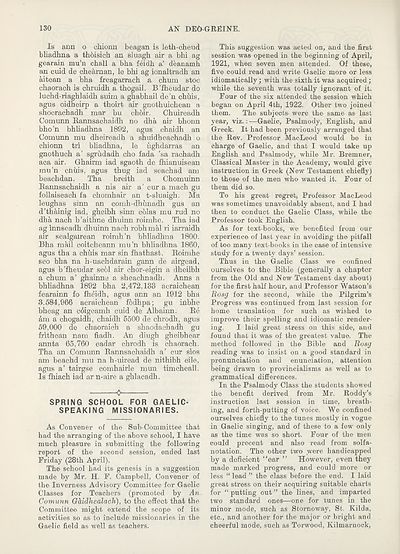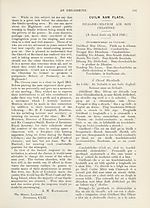An Comunn Gàidhealach Publications > Deo-gréine > Volume 17, October 1921 to September 1922
(138) Page 130
‹‹‹ prev (137)
Earrann 9, Dara Mìos an t-Samhraidh, 1922
Download files
Complete book:
Individual page:
Thumbnail gallery: Grid view | List view

130
AN DEO-GMNE.
Is ann o chionn beagan is leth-cheud
bliadhna a thbisich an sluagh air a bhi ag
gearain mu’n chall a bha feidh a’ deanamh
an cuid de chekman, le bhi ag ionaltradh an
aitean a bha freagarrach a chum stoc
chaorach is chruidh a thogail. B’fheudar do
luchd-riaghlaidh suim a ghabhail de’n chuis,
agus oidheirp a thoirt air gnothuichean a
shocrachadh mar bu chbir. Chuireadh
Comunn Bannsachaidh no dha air bhonn
bho’n bhliadhna 1892, agus chaidh an
Comunn mu dheireadh a shuidheachadh o
chionn tri bliadhna, le iighdarras an
gnothuch a’ sgriidadh cho fada ’sa rachadh
aca air. Ghairm iad sgaoth de fhianuisean
mu’n cniiis, agus thug iad seachad am
beachdan. Tha breith a Chomuinn
Bannsachaidh a nis air a’ cur a mach gu
follaiseach fa chomhair an t-sluaigh. Ma
leughas sinn an comh-dhunadh gus an
d’thainig iad, gheibh sinn eblas mu rud no
dha nach b’aithne dhuinn roimhe. Tha iad
ag Innseadh dhuinn nach robhmal ri iarraidh
air sealgairean roimh’n bhliadhna 1800.
Bha mail coitcheann mu’n bhliadhna 1860,
agus tha a chuis mar sin fhathast. Boimhe
seo bha na h-uachdarain gann de airgead,
agus b’fheudar seol air chor-eigin a dheilbh
a chum a’ ghainna a sheachnadh. Anns a
bhliadhna 1892 bha 2,472,133 acraichean
fearainn fo fheidh, agus ann an 1912 bha
3,584,966 acraichean fodhpa; gu inbhe
bheag an cdigeamh cuid de Albainn. Be
dm a chogaidh, chaidh 5500 de chrodh, agus
59,000 de chaoraich a shaodachadh gu
frlthean nam fiadh. An diugh gheibhear
annta 65,760 eadar chrodh is chaorach.
Tha an Comunn Bannsachaidh a’ cur slos
am beachd mu na h-uiread de nithibh eile,
agus a’ tairgse comhairle mun timcheall.
Is fhiach iad ar n-aire a ghlacadh.
0
SPRING SCHOOL FOR GAELIC¬
SPEAKING MISSIONARIES.
As Convener of the Sub-Committee that
had the arranging of the above school, I have
much pleasure in submitting the following
report of the second session, ended last
Friday (28th April).
The school had its genesis in a suggestion
made by Mr. H. F. Campbell, Convener of
the Inverness Advisory Committee for Gaelic
Classes for Teachers (promoted by An.
Comunn Gaidhealach), to the effect that the
Committee might extend the scope of its
activities so as to include missionaries in the
Gaelic field as well as teachers.
This suggestion was acted on, and the first
session was opened in the beginning of April,
1921, when seven men attended. Of these,
five could read and write Gaelic more or less
idiomatically; with the sixth it was acquired;
while the seventh was totally ignorant of it.
Four of the six attended the session which
began on April 4th, 1922. Other two joined
them. The subjects were the same as last
year, viz. : —Gaelic, Psalmody, English, and
Greek. It had been previously arranged that
the Bev. Professor MacLeod would be in
charge of Gaelic, and that I would take up
English and Psalmody, while Mr. Bremner,
Classical Master in the Academy, would give
instruction in Greek (New Testament chiefly)
to those of the men who wanted it. Four of
them did so.
To his great regret, Professor MacLeod
was sometimes unavoidably absent, and I had
then to conduct the Gaelic Class, while the
Professor took English.
As for text-books, we benefited from our
experience of last year in avoiding the pitfall
of too many text-books in the case of intensive
study for a twenty days’ session.
Thus in the Gaelic Class we confined
ourselves to the Bible (generally a chapter
from the Old and New Testament day about)
for the first half hour, and Professor Watson’s
Rosg for the second, while the Pilgrim’s
Progress was continued from last session for
home translation for such as wished to
improve their spelling and idiomatic render¬
ing. I laid great stress on this side, and
found that it was of the greatest value. The
method followed in the Bible and Rosg
reading was to insist on a good standard in
pronunciation and enunciation, attention
being drawn to provincialisms as well as to
grammatical differences.
In the Psalmody Class the students showed
the benefit derived from Mr. Boddy’s
instruction last session in time, breath¬
ing, and forth-putting of voice. We confined
ourselves chiefly to the tunes mostly in vogue
in Gaelic singing, and of these to a few only
as the time was so short. Four of the men
could precent and also read from solfa-
notation. The other two _were handicapped
by a deficient “ear ’’ However, even they
made marked progress, and could more or
less “ lead ” the class before the end. I laid
great stress on their acquiring suitable charts
for “ putting out ” the lines, and imparted
two standard ones—one for tunes in the
minor mode, such as Stornoway, St. Kilda,
etc., and another for the major or bright and
cheerful mode, such as Torwood, Kilmarnock,
AN DEO-GMNE.
Is ann o chionn beagan is leth-cheud
bliadhna a thbisich an sluagh air a bhi ag
gearain mu’n chall a bha feidh a’ deanamh
an cuid de chekman, le bhi ag ionaltradh an
aitean a bha freagarrach a chum stoc
chaorach is chruidh a thogail. B’fheudar do
luchd-riaghlaidh suim a ghabhail de’n chuis,
agus oidheirp a thoirt air gnothuichean a
shocrachadh mar bu chbir. Chuireadh
Comunn Bannsachaidh no dha air bhonn
bho’n bhliadhna 1892, agus chaidh an
Comunn mu dheireadh a shuidheachadh o
chionn tri bliadhna, le iighdarras an
gnothuch a’ sgriidadh cho fada ’sa rachadh
aca air. Ghairm iad sgaoth de fhianuisean
mu’n cniiis, agus thug iad seachad am
beachdan. Tha breith a Chomuinn
Bannsachaidh a nis air a’ cur a mach gu
follaiseach fa chomhair an t-sluaigh. Ma
leughas sinn an comh-dhunadh gus an
d’thainig iad, gheibh sinn eblas mu rud no
dha nach b’aithne dhuinn roimhe. Tha iad
ag Innseadh dhuinn nach robhmal ri iarraidh
air sealgairean roimh’n bhliadhna 1800.
Bha mail coitcheann mu’n bhliadhna 1860,
agus tha a chuis mar sin fhathast. Boimhe
seo bha na h-uachdarain gann de airgead,
agus b’fheudar seol air chor-eigin a dheilbh
a chum a’ ghainna a sheachnadh. Anns a
bhliadhna 1892 bha 2,472,133 acraichean
fearainn fo fheidh, agus ann an 1912 bha
3,584,966 acraichean fodhpa; gu inbhe
bheag an cdigeamh cuid de Albainn. Be
dm a chogaidh, chaidh 5500 de chrodh, agus
59,000 de chaoraich a shaodachadh gu
frlthean nam fiadh. An diugh gheibhear
annta 65,760 eadar chrodh is chaorach.
Tha an Comunn Bannsachaidh a’ cur slos
am beachd mu na h-uiread de nithibh eile,
agus a’ tairgse comhairle mun timcheall.
Is fhiach iad ar n-aire a ghlacadh.
0
SPRING SCHOOL FOR GAELIC¬
SPEAKING MISSIONARIES.
As Convener of the Sub-Committee that
had the arranging of the above school, I have
much pleasure in submitting the following
report of the second session, ended last
Friday (28th April).
The school had its genesis in a suggestion
made by Mr. H. F. Campbell, Convener of
the Inverness Advisory Committee for Gaelic
Classes for Teachers (promoted by An.
Comunn Gaidhealach), to the effect that the
Committee might extend the scope of its
activities so as to include missionaries in the
Gaelic field as well as teachers.
This suggestion was acted on, and the first
session was opened in the beginning of April,
1921, when seven men attended. Of these,
five could read and write Gaelic more or less
idiomatically; with the sixth it was acquired;
while the seventh was totally ignorant of it.
Four of the six attended the session which
began on April 4th, 1922. Other two joined
them. The subjects were the same as last
year, viz. : —Gaelic, Psalmody, English, and
Greek. It had been previously arranged that
the Bev. Professor MacLeod would be in
charge of Gaelic, and that I would take up
English and Psalmody, while Mr. Bremner,
Classical Master in the Academy, would give
instruction in Greek (New Testament chiefly)
to those of the men who wanted it. Four of
them did so.
To his great regret, Professor MacLeod
was sometimes unavoidably absent, and I had
then to conduct the Gaelic Class, while the
Professor took English.
As for text-books, we benefited from our
experience of last year in avoiding the pitfall
of too many text-books in the case of intensive
study for a twenty days’ session.
Thus in the Gaelic Class we confined
ourselves to the Bible (generally a chapter
from the Old and New Testament day about)
for the first half hour, and Professor Watson’s
Rosg for the second, while the Pilgrim’s
Progress was continued from last session for
home translation for such as wished to
improve their spelling and idiomatic render¬
ing. I laid great stress on this side, and
found that it was of the greatest value. The
method followed in the Bible and Rosg
reading was to insist on a good standard in
pronunciation and enunciation, attention
being drawn to provincialisms as well as to
grammatical differences.
In the Psalmody Class the students showed
the benefit derived from Mr. Boddy’s
instruction last session in time, breath¬
ing, and forth-putting of voice. We confined
ourselves chiefly to the tunes mostly in vogue
in Gaelic singing, and of these to a few only
as the time was so short. Four of the men
could precent and also read from solfa-
notation. The other two _were handicapped
by a deficient “ear ’’ However, even they
made marked progress, and could more or
less “ lead ” the class before the end. I laid
great stress on their acquiring suitable charts
for “ putting out ” the lines, and imparted
two standard ones—one for tunes in the
minor mode, such as Stornoway, St. Kilda,
etc., and another for the major or bright and
cheerful mode, such as Torwood, Kilmarnock,
Set display mode to:
![]() Universal Viewer |
Universal Viewer | ![]() Mirador |
Large image | Transcription
Mirador |
Large image | Transcription
| An Comunn Gàidhealach > An Comunn Gàidhealach Publications > Deo-gréine > Volume 17, October 1921 to September 1922 > (138) Page 130 |
|---|
| Permanent URL | https://digital.nls.uk/127171629 |
|---|
| Description | Leabhar 17, Treasamh Mios an Fhoghair 1921 gu Dara Mìos an Fhoghair 1922 |
|---|---|
| Attribution and copyright: |
|
| Description | This contains items published by An Comunn, which are not specifically Mòd-related. It includes journals, annual reports and corporate documents, policy statements, educational resources and published plays and literature. It is arranged alphabetically by title. |
|---|
| Description | A collection of over 400 items published by An Comunn Gàidhealach, the organisation which promotes Gaelic language and culture and organises the Royal National Mòd. Dating from 1891 up to the present day, the collection includes journals and newspapers, annual reports, educational materials, national Mòd programmes, published Mòd literature and music. |
|---|---|
| Additional NLS resources: |
|
